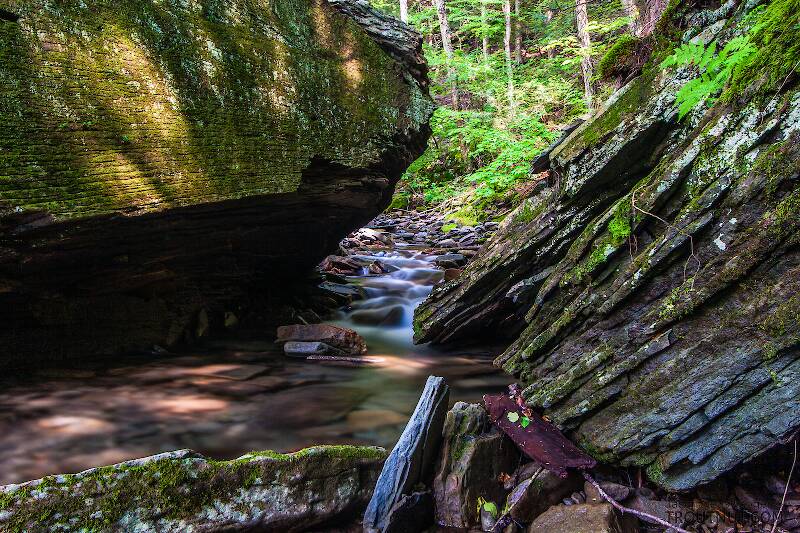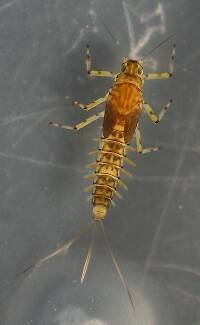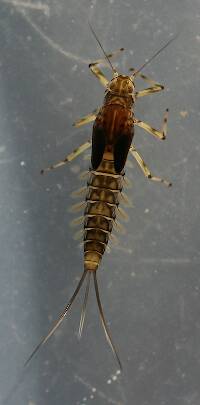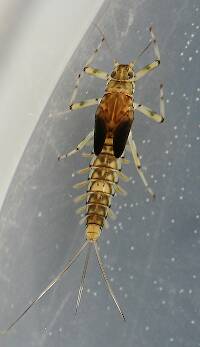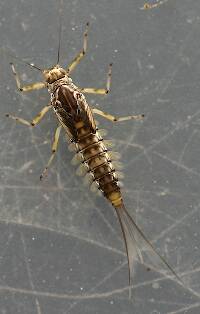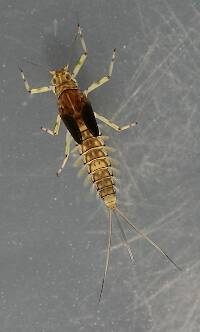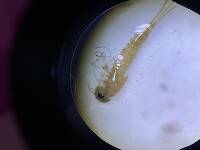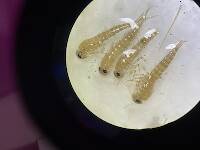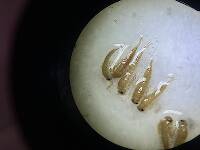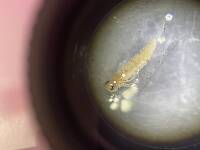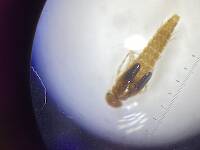
Hex Mayflies
Hexagenia limbata
The famous nocturnal Hex hatch of the Midwest (and a few other lucky locations) stirs to the surface mythically large brown trout that only touch streamers for the rest of the year.
Featured on the forum


Troutnut is a project started in 2003 by salmonid ecologist Jason "Troutnut" Neuswanger to help anglers and
fly tyers unabashedly embrace the entomological side of the sport. Learn more about Troutnut or
support the project for an enhanced experience here.
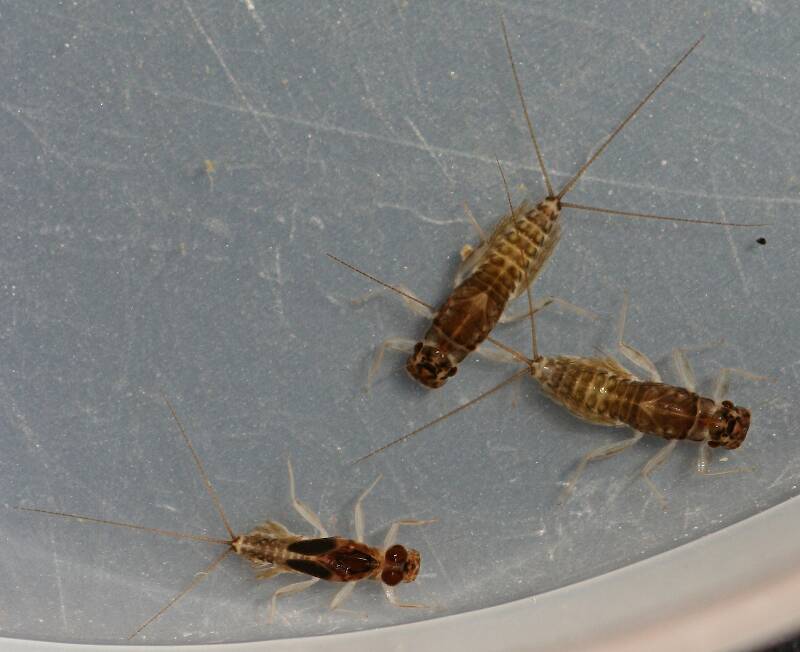
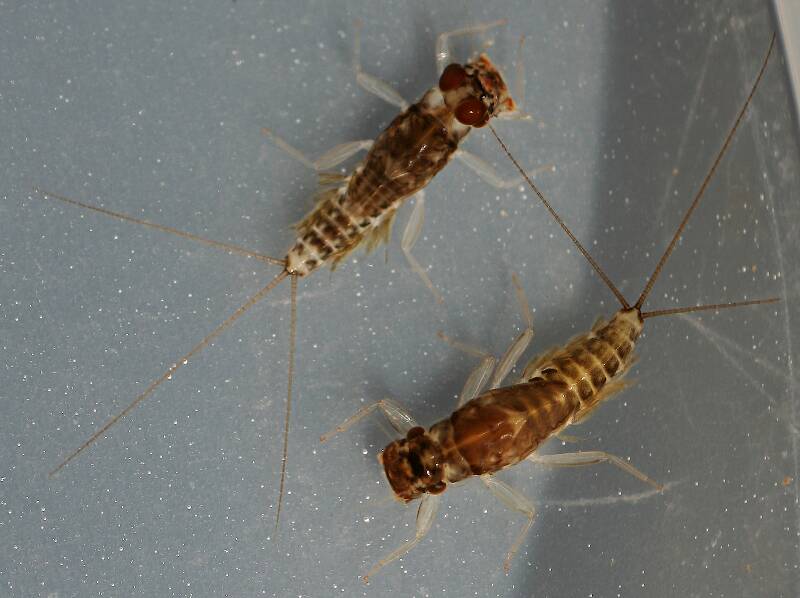
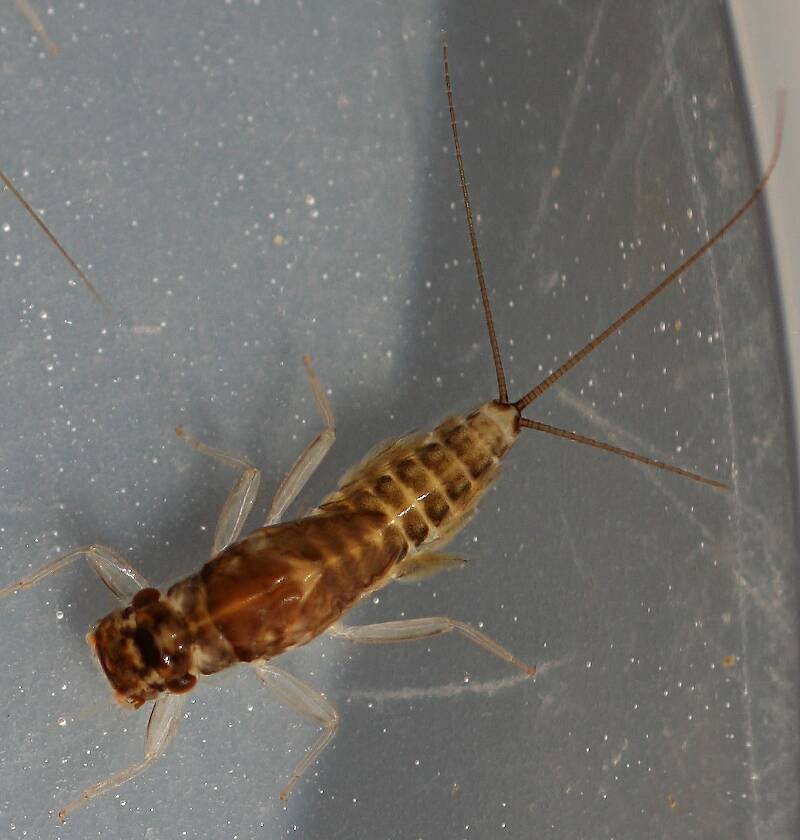
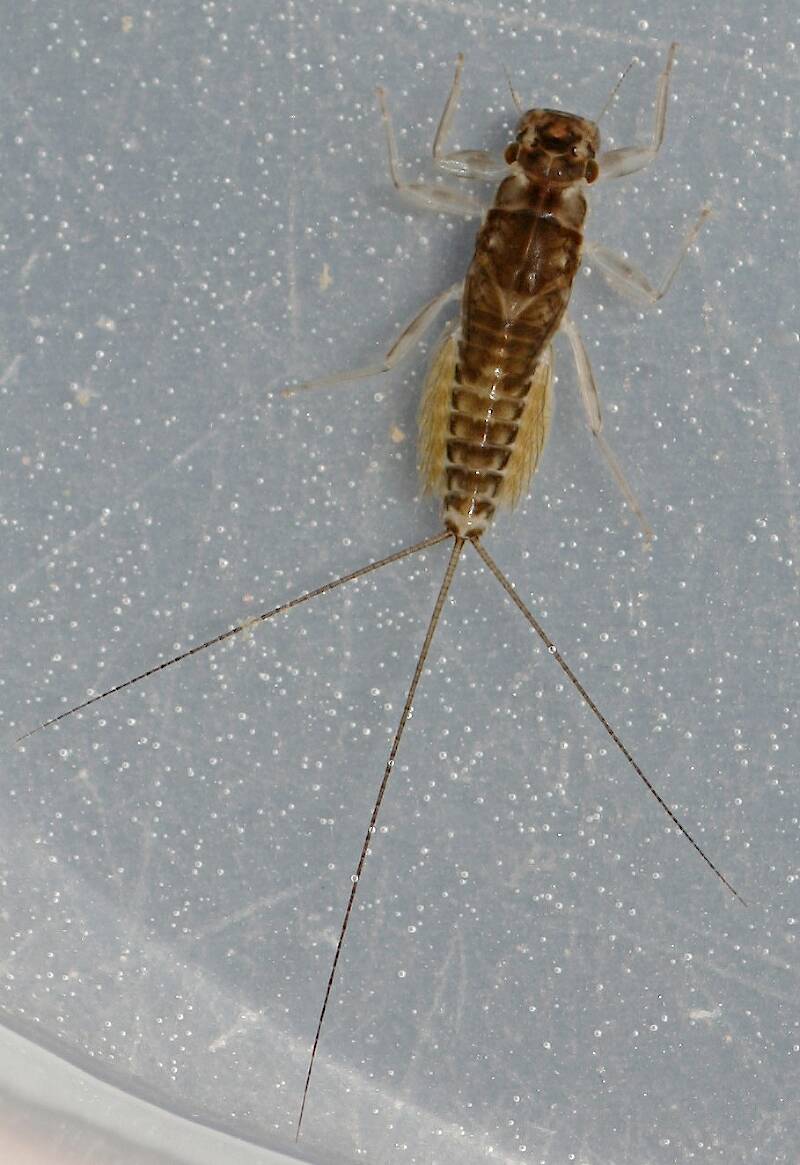
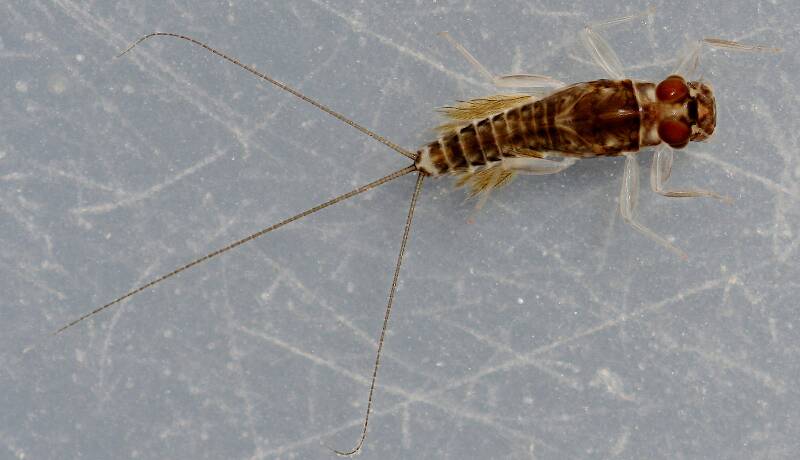
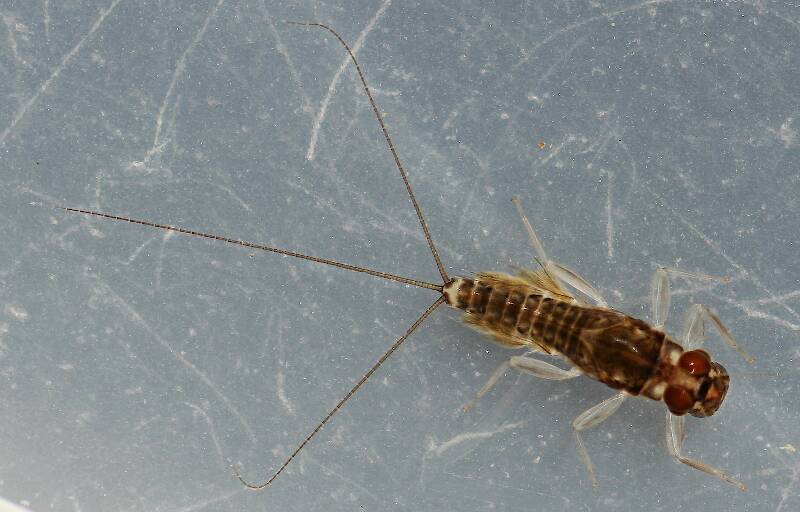
Millcreek on Sep 5, 2014September 5th, 2014, 6:35 pm EDT
These are very common in the Russian River from late May through mid November. I've been able to key the nymphs to Choroterpes using Merritt, Cummins and Berg.
There are three reported species of Choroterpes in California, C. albiannulata, C. inornata and C. terratoma. There is no description of the larvae of C. terratoma and the larval descriptions of C. albiannulata and C. inornata are very similar. About the only diagnostic difference seems to be the number of denticles on the claws, 9-11 for C. albiannulata and 13-14 for C. inornata. To further complicate that difference an unpublished key lists the number of denticles as 8-11 for C. albiannulata and 12-15 for C. inornata. Since I count 12 denticles on each claw I'm not overflowing with confidence about deciding which species it is.
Does anybody here have any experience with this genus?
There are three reported species of Choroterpes in California, C. albiannulata, C. inornata and C. terratoma. There is no description of the larvae of C. terratoma and the larval descriptions of C. albiannulata and C. inornata are very similar. About the only diagnostic difference seems to be the number of denticles on the claws, 9-11 for C. albiannulata and 13-14 for C. inornata. To further complicate that difference an unpublished key lists the number of denticles as 8-11 for C. albiannulata and 12-15 for C. inornata. Since I count 12 denticles on each claw I'm not overflowing with confidence about deciding which species it is.
Does anybody here have any experience with this genus?
"If we knew what it was we were doing, it would not be called research, would it?"
-Albert Einstein
-Albert Einstein
Millcreek on Sep 7, 2014September 7th, 2014, 9:58 am EDT
Thought I'd include a little more info and some links to literature on Choroterpes. Burian (1995) states that C. terratoma has 8-10 denticles on each claw but doesn't offer much other info on the larvae. The larvae were described by Seemann in 1927 but trying to find the actual paper has proven fruitless.
Kilgore and Allen describe C. inornata larvae but the association with adults is inferred from their geographic proximity to adults. Link is here: http://www.ephemeroptera-galactica.com/pubs/pub_k/pubkilgorej1973p321.pdf
McCafferty describes the nymph of C. albiannulata from reared specimens here: http://www.ephemeroptera-galactica.com/pubs/pub_m/pubmccaffertyw1992p71.pdf.
Burian describes adults and nymphs of eastern species with some notes on western species here: http://www.ephemeroptera-galactica.com/pubs/pub_b/pubburians1995p433.pdf.
Kilgore and Allen describe C. inornata larvae but the association with adults is inferred from their geographic proximity to adults. Link is here: http://www.ephemeroptera-galactica.com/pubs/pub_k/pubkilgorej1973p321.pdf
McCafferty describes the nymph of C. albiannulata from reared specimens here: http://www.ephemeroptera-galactica.com/pubs/pub_m/pubmccaffertyw1992p71.pdf.
Burian describes adults and nymphs of eastern species with some notes on western species here: http://www.ephemeroptera-galactica.com/pubs/pub_b/pubburians1995p433.pdf.
"If we knew what it was we were doing, it would not be called research, would it?"
-Albert Einstein
-Albert Einstein
Entoman on Sep 8, 2014September 8th, 2014, 6:10 pm EDT
Hi Mark,
Sorry for not responding sooner. I opened it when I didn't have time to reply. That caused it to lose its topic highlight and so forgot it for a few days. Ah, the old short term memory ain't what it used to be... ;)
Yes, those are the papers I'm aware of that are a little helpful. McCafferty seems the most, though. He states that head capsule and femoral maculae are probably quite distinct between albiannulata and inornata. C. albiannulata has a dark bar forward on the frons clearly lacking on your specimens. The pale femoral maculae on your specimens may also point to inornata. However, they are pretty pale and the tails are quite long which is not supposed to be a character of either species. This latter character is also purported to have probable diagnostic value. So... Perhaps you have examples of the undescribed terratoma? :)
Sorry for not responding sooner. I opened it when I didn't have time to reply. That caused it to lose its topic highlight and so forgot it for a few days. Ah, the old short term memory ain't what it used to be... ;)
Yes, those are the papers I'm aware of that are a little helpful. McCafferty seems the most, though. He states that head capsule and femoral maculae are probably quite distinct between albiannulata and inornata. C. albiannulata has a dark bar forward on the frons clearly lacking on your specimens. The pale femoral maculae on your specimens may also point to inornata. However, they are pretty pale and the tails are quite long which is not supposed to be a character of either species. This latter character is also purported to have probable diagnostic value. So... Perhaps you have examples of the undescribed terratoma? :)
"It's not that I find fishing so important, it's just that I find all other endeavors of Man equally unimportant... And not nearly as much fun!" Robert Traver, Anatomy of a Fisherman
Millcreek on Sep 8, 2014September 8th, 2014, 9:35 pm EDT
Kurt -
If I had to guess I'd say that they're C. inornata. Of course that's all it is, a guess. Just not enough info available to determine the species with any certainty. Think I'll just go with Choroterpes sp. #1.
As far as C. terratoma I'm not even entirely sure it exists. The last description of it I've found is Day's account in Aquatic Insects of California where he says the type locality is Los angeles County and that the nymphs have been found in the Coast Range, north of San Francisco. At the time his account was written C. terratoma was considered the only species of Choroterpes in California and the description of the nymph was more generic than specific. That describes most if not all Choroterpes nymphs. The only other tidbit I found was in Burian's paper where he mentions that the nymphs have 8-10 denticles on each claw. That would rule out the nymphs in the photos since they have twelve denticles per claw.
At any rate, trying to figure this out reminds me of an exchange between Alice and the Mad Hatter:
The quote works well when you're trying to identify Baetis species as well.:)
If I had to guess I'd say that they're C. inornata. Of course that's all it is, a guess. Just not enough info available to determine the species with any certainty. Think I'll just go with Choroterpes sp. #1.
As far as C. terratoma I'm not even entirely sure it exists. The last description of it I've found is Day's account in Aquatic Insects of California where he says the type locality is Los angeles County and that the nymphs have been found in the Coast Range, north of San Francisco. At the time his account was written C. terratoma was considered the only species of Choroterpes in California and the description of the nymph was more generic than specific.
Nymph - Depressed in form; eyes of male nymph dorsal; eyes of female nymph at dorsolateral margins of head; head wide, flat and relatively large.
At any rate, trying to figure this out reminds me of an exchange between Alice and the Mad Hatter:
“Mad Hatter: “Why is a raven like a writing-desk?”
“Have you guessed the riddle yet?” the Hatter said, turning to Alice again.
“No, I give it up,” Alice replied: “What’s the answer?”
“I haven’t the slightest idea,” said the Hatter”
The quote works well when you're trying to identify Baetis species as well.:)
"If we knew what it was we were doing, it would not be called research, would it?"
-Albert Einstein
-Albert Einstein
Entoman on Sep 9, 2014September 9th, 2014, 4:00 am EDT
Yeah, you've got that right... ;)
E. dorothea infrequens and the various forms of E. excrucians will also give one fits. Abdominal markings are not reliable as once thought and even size above 18 is not helpful either. Supposedly, subtle differences in claw curvature is now considered determinative but I've observed way too many specimens that are tweeners in this regard. About the only way one can know for sure is based on intimate knowledge of the particular stream as the former hatches first and only lasts a few weeks. Not very helpful when somebody submits a photo early in the Summer from a location where we haven't been. The Flav complex is also a bit jumbled. I'm working on some Fall hatching Idaho leptophlibids that don't fit into the available boxes as well...
The more we learn the more we become aware of what we don't know. Species concepts are far from cut and dry. Angler entos like Rick Hafele are now wisely shying away from publishing species opinions for many if not most of our hatches in the latest generation of texts.
E. dorothea infrequens and the various forms of E. excrucians will also give one fits. Abdominal markings are not reliable as once thought and even size above 18 is not helpful either. Supposedly, subtle differences in claw curvature is now considered determinative but I've observed way too many specimens that are tweeners in this regard. About the only way one can know for sure is based on intimate knowledge of the particular stream as the former hatches first and only lasts a few weeks. Not very helpful when somebody submits a photo early in the Summer from a location where we haven't been. The Flav complex is also a bit jumbled. I'm working on some Fall hatching Idaho leptophlibids that don't fit into the available boxes as well...
The more we learn the more we become aware of what we don't know. Species concepts are far from cut and dry. Angler entos like Rick Hafele are now wisely shying away from publishing species opinions for many if not most of our hatches in the latest generation of texts.
"It's not that I find fishing so important, it's just that I find all other endeavors of Man equally unimportant... And not nearly as much fun!" Robert Traver, Anatomy of a Fisherman
Millcreek on Sep 9, 2014September 9th, 2014, 8:09 am EDT
E. dorothea infrequens and the various forms of E. excrucians will also give one fits.
Been there, done that and they gave me the fantods. Finally settled on E. dorothea. I no longer remember just exactly what my reasoning was although I remember claw curvature was part of it.
E. dorothea show some real variation in coloring. Seem to be sporadic in this area but I've found them in the Russian River and Mill Creek. I posted some photos on Bugguide that show some of the variations. They can be seen here;http://bugguide.net/node/view/882430 and here:http://bugguide.net/node/view/882559
The more we learn the more we become aware of what we don't know.
Hopefully that's true. If you aren't asking questions you're not learning.
"If we knew what it was we were doing, it would not be called research, would it?"
-Albert Einstein
-Albert Einstein
PaulRoberts on Sep 9, 2014September 9th, 2014, 3:59 pm EDT
Interesting. Are these Ephemerellidae or Leptophlebiidae?
Entoman on Sep 9, 2014September 9th, 2014, 4:25 pm EDT
The latter, Paul. Sorry for the interjected (and off topic) anecdote on the PMD's.
"It's not that I find fishing so important, it's just that I find all other endeavors of Man equally unimportant... And not nearly as much fun!" Robert Traver, Anatomy of a Fisherman
Millcreek on Sep 9, 2014September 9th, 2014, 4:27 pm EDT
Interesting. Are these Ephemerellidae or Leptophlebiidae?
Paul, the nymphs in the photos are Leptophlebiidae. Kurt and I got sidetracked about about the difficulties of identifying some nymphs to species and started using Ephemerella dorothea and E. excrucians as an example. Both those species belong in Ephemerellidae.
"If we knew what it was we were doing, it would not be called research, would it?"
-Albert Einstein
-Albert Einstein
PaulRoberts on Sep 9, 2014September 9th, 2014, 7:32 pm EDT
The latter, Paul. Sorry for the interjected (and off topic) anecdote on the PMD's.
Entoman on Sep 10, 2014September 10th, 2014, 8:27 am EDT
Anglers lump them together in the Crawler category for reasons of efficiency, I guess - not wanting to add a 5th category? Anyway, in the latest taxonomic revisions that incorporate phylogenetic findings they're not that close. If we consider the Order to be the main stem they branch apart quickly at only the second fork. While they spring from the same first fork suborder branch (Furcatergalia), they are on different infraorder branches. The leptophlebids are on Lanceolata and the ephemerellids are on Pannota. However, they are closer to each other than they are to the baetids and heptageniids that are on the different first fork suborder branch Pisciforma.
"It's not that I find fishing so important, it's just that I find all other endeavors of Man equally unimportant... And not nearly as much fun!" Robert Traver, Anatomy of a Fisherman
Konchu on Sep 10, 2014September 10th, 2014, 1:59 pm EDT
Elsewhere in the world, the leptos have gone nuts and fill most niches that other mayfly taxa fill.
PaulRoberts on Sep 10, 2014September 10th, 2014, 8:44 pm EDT
Neat. Thanks Kurt and Luke. And Mark for the images.
Millcreek on Sep 11, 2014September 11th, 2014, 11:37 am EDT
Elsewhere in the world, the leptos have gone nuts and fill most niches that other mayfly taxa fill.
I guess so. Got curious and took a cursory look at some sites. Apparently Central and South America, Africa and Australia are centers for Leptophlebiidae diversity. Australia has approximately 20 genera of Leptophlebiidae and South America 40 genera. Looks like new genera and species are continuing to be described.
Interesting article in Zootaxa about South American Leptophlebiidae. Link is here http://www.academia.edu/7961623/Ephemeroptera_from_the_Venezuelan_Guayanas_s_Uplands_Families_Leptophlebiidae_Euthyplociidae_and_Oligoneuriidae
Be sure to check out the photos of "Old Shovelhead", Paramaka incognito on page 309.
"If we knew what it was we were doing, it would not be called research, would it?"
-Albert Einstein
-Albert Einstein
Crepuscular on Sep 11, 2014September 11th, 2014, 12:35 pm EDT
Be sure to check out the photos of "Old Shovelhead", Paramaka incognito on page 309.
Whoa! Hardly traveling around incognito...
Millcreek on Sep 11, 2014September 11th, 2014, 4:09 pm EDT
Whoa! Hardly traveling around incognito...
He's trying, those turbinate eyes look like sunglasses.
"If we knew what it was we were doing, it would not be called research, would it?"
-Albert Einstein
-Albert Einstein
Oldredbarn on Sep 15, 2014September 15th, 2014, 7:21 am EDT
I've got my eyes on you, so best beware where you roam.
I've got my eyes on you, so don't stray too far from home.
Incidentally, I've set my spies on you,
I'm checking all you do, from a to zee.
So, darling, just be wise, keep your eyes on me.
Sorry Boys! I couldn't resist. :) Honest...
Spence
"Even when my best efforts fail it's a satisfying challenge, and that, after all, is the essence of fly fishing." -Chauncy Lively
"Envy not the man who lives beside the river, but the man the river flows through." Joseph T Heywood
"Envy not the man who lives beside the river, but the man the river flows through." Joseph T Heywood
Millcreek on Sep 15, 2014September 15th, 2014, 10:29 am EDT
Spence,
Resistance is futile. Pretty good, I almost sprayed a mouthful of coffee over the laptop.
I couldn't resist. :)
Resistance is futile. Pretty good, I almost sprayed a mouthful of coffee over the laptop.
"If we knew what it was we were doing, it would not be called research, would it?"
-Albert Einstein
-Albert Einstein
Oldredbarn on Sep 15, 2014September 15th, 2014, 5:28 pm EDT
:)
"Even when my best efforts fail it's a satisfying challenge, and that, after all, is the essence of fly fishing." -Chauncy Lively
"Envy not the man who lives beside the river, but the man the river flows through." Joseph T Heywood
"Envy not the man who lives beside the river, but the man the river flows through." Joseph T Heywood
Quick Reply
Related Discussions
Topic
Replies
Last Reply
8
Jun 5, 2007
by Dinerobyn
by Dinerobyn
Re: Help obtaining photos of larval insects for a City of Denton, TX photographic key to ID'ing.
In the Identify This! Board by Rdjudy
In the Identify This! Board by Rdjudy
1
Jul 28, 2008
by Taxon
by Taxon

